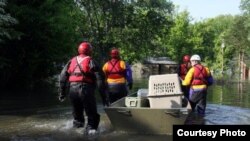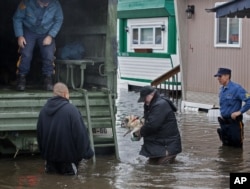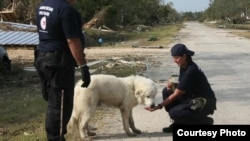PORTLAND, OREGON —
Despite the looming danger of wind and flood damage from Hurricane Sandy, many coastal residents in the northeastern United States refused to leave their homes. In many cases, it was because they didn't want to leave their pets behind.
Nearly two-thirds of American households include a cat, dog or other pet, and many people regard their animals as family members.
The Oregon Humane Society, which is spreading the word about including animals in emergency preparedness, is offering workshops on the topic.
At a recent workshop in Portland, instructor Jo Becker started with a slide montage of images from the October storm which battered New York and New Jersey with gale-force winds, torrential rain and record flooding.
"Firemen immersing themselves in chest-deep water for dogs and cats," she says, referring to the images. "We don't want our firefighters immersing themselves in polluted water."
During Hurricane Sandy, some of the people who stayed behind to be with their pets drowned in their homes.
"Emergency shelters won't accept animals," Becker says. "If you're lucky, people and animal shelters will be located close to each other."
It's nationwide policy to keep pets, except for service animals, out of human shelters.
"They don't accept animals in the shelters because of public health issues," Becker says.
There are also issues with allergies, the potential for animals to fight with each other and to bite others.
According to the pet products industry, the majority of American households - nearly 73 million - own pets.
Wendy Colvin, who attended Becker's workshop, wonders what would become of her pets in the event of a disaster. She lives on rural property near Canby, Oregon, with two pygmy goats and about a dozen chickens.
The devastation wreaked by Hurricane Katrina along the U.S. Gulf coast in 2005 motivated Colvin to volunteer with Mennonite Disaster Services. She's learned about helping her human neighbors recover from catastrophe, but hasn't really thought about how to deal with her animals.
Emergency shelter rules which forbid pets create something of a puzzle for her.
"If we had to move them [our animals], we would probably put them into the pickup truck and take them wherever we had to go," Colvin says.
About two hours north, near Olympia, Washington, veterinarian tech Hollie Smith has a plan for her menagerie. She owns two cats, a dog and two rabbits. She's packed plastic totes with seven days of pet litter, food and toys. She has pet carriers and a collapsible playpen for the rabbits at the ready.
But personal preparedness isn't good enough for Smith.
"My biggest thing is getting the government to realize that animals need to be part of the solution and part of the plans," she says. "Otherwise, they are going to be a major hiccup, a major problem."
When Smith inquired about her own county's shelter plan for animals, she found it wanting. So she volunteered to work on an animal and agriculture disaster plan for Thurston County Emergency Management.
"We're looking at several different horse arenas, horse stable facilities, dairy farms. We have a couple of dairy farms, or cattle farms, that have gone out of business," she says. "The properties are there. They have everything there on the property, stables and all that stuff. We could just come in and use them."
Thurston County is one of many communities working on a better approach for dealing with animals in disasters. A little-known post-Hurricane Katrina reform called the Federal PETS Act requires state and local governments to plan for animals in emergencies, though it's unclear how or if that law is enforced.
Local and national animal advocacy groups routinely mobilize during disasters to help evacuate people and their pets, corral lost animals to be reunited with their owners, and supply emergency food and supplies to overwhelmed animal shelters.
And they all stress that a good rule of thumb is, whatever you do for yourself to get ready for emergencies, do the same thing for your pets.
Nearly two-thirds of American households include a cat, dog or other pet, and many people regard their animals as family members.
The Oregon Humane Society, which is spreading the word about including animals in emergency preparedness, is offering workshops on the topic.
At a recent workshop in Portland, instructor Jo Becker started with a slide montage of images from the October storm which battered New York and New Jersey with gale-force winds, torrential rain and record flooding.
"Firemen immersing themselves in chest-deep water for dogs and cats," she says, referring to the images. "We don't want our firefighters immersing themselves in polluted water."
During Hurricane Sandy, some of the people who stayed behind to be with their pets drowned in their homes.
"Emergency shelters won't accept animals," Becker says. "If you're lucky, people and animal shelters will be located close to each other."
It's nationwide policy to keep pets, except for service animals, out of human shelters.
"They don't accept animals in the shelters because of public health issues," Becker says.
There are also issues with allergies, the potential for animals to fight with each other and to bite others.
According to the pet products industry, the majority of American households - nearly 73 million - own pets.
Wendy Colvin, who attended Becker's workshop, wonders what would become of her pets in the event of a disaster. She lives on rural property near Canby, Oregon, with two pygmy goats and about a dozen chickens.
The devastation wreaked by Hurricane Katrina along the U.S. Gulf coast in 2005 motivated Colvin to volunteer with Mennonite Disaster Services. She's learned about helping her human neighbors recover from catastrophe, but hasn't really thought about how to deal with her animals.
Emergency shelter rules which forbid pets create something of a puzzle for her.
"If we had to move them [our animals], we would probably put them into the pickup truck and take them wherever we had to go," Colvin says.
About two hours north, near Olympia, Washington, veterinarian tech Hollie Smith has a plan for her menagerie. She owns two cats, a dog and two rabbits. She's packed plastic totes with seven days of pet litter, food and toys. She has pet carriers and a collapsible playpen for the rabbits at the ready.
But personal preparedness isn't good enough for Smith.
"My biggest thing is getting the government to realize that animals need to be part of the solution and part of the plans," she says. "Otherwise, they are going to be a major hiccup, a major problem."
When Smith inquired about her own county's shelter plan for animals, she found it wanting. So she volunteered to work on an animal and agriculture disaster plan for Thurston County Emergency Management.
"We're looking at several different horse arenas, horse stable facilities, dairy farms. We have a couple of dairy farms, or cattle farms, that have gone out of business," she says. "The properties are there. They have everything there on the property, stables and all that stuff. We could just come in and use them."
Thurston County is one of many communities working on a better approach for dealing with animals in disasters. A little-known post-Hurricane Katrina reform called the Federal PETS Act requires state and local governments to plan for animals in emergencies, though it's unclear how or if that law is enforced.
Local and national animal advocacy groups routinely mobilize during disasters to help evacuate people and their pets, corral lost animals to be reunited with their owners, and supply emergency food and supplies to overwhelmed animal shelters.
And they all stress that a good rule of thumb is, whatever you do for yourself to get ready for emergencies, do the same thing for your pets.









